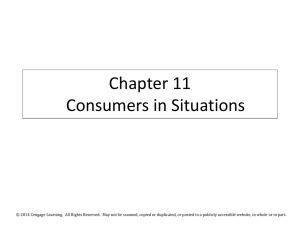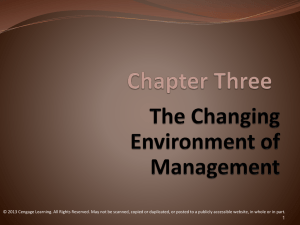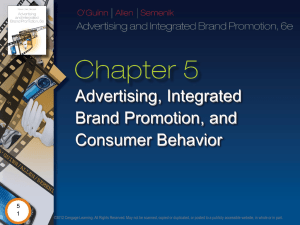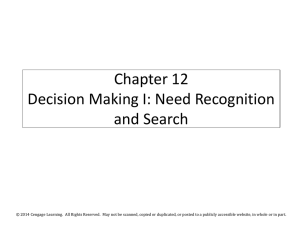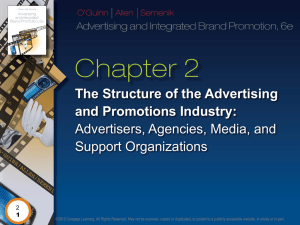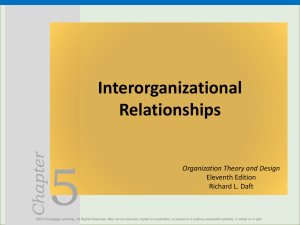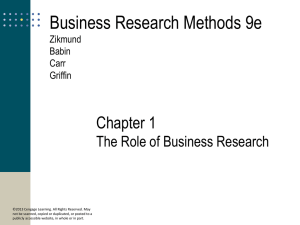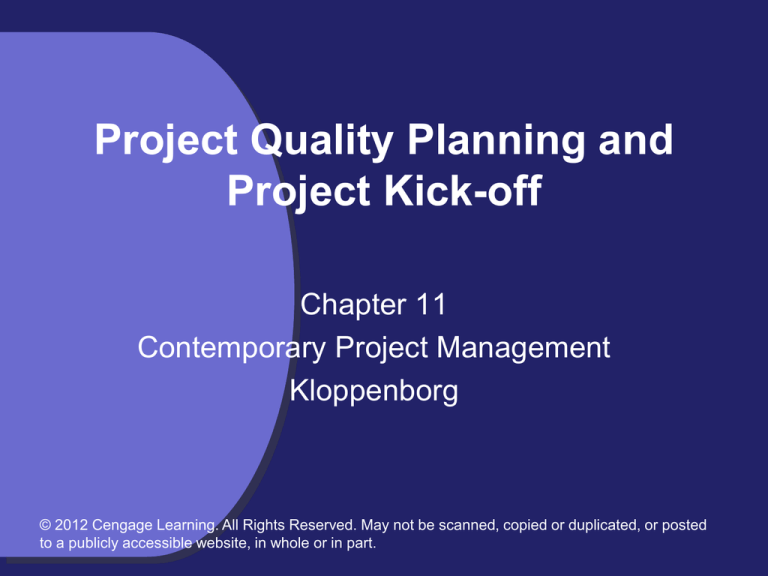
Project Quality Planning and
Project Kick-off
Chapter 11
Contemporary Project Management
Kloppenborg
© 2012 Cengage Learning. All Rights Reserved. May not be scanned, copied or duplicated, or posted
to a publicly accessible website, in whole or in part.
Chapter
Vignette
Dealing with Quality at Advantex, Inc.
• Advantex, Inc.’s business is to manufacture
custom-made precision components to meet
customers’ specifications
• Applying the “Law of Attraction” to the quality
issue – focus on good quality products and
happy customers
• Discover the effective habits of people making
good quality products
© 2012 Cengage Learning. All Rights Reserved. May not be scanned, copied or duplicated, or posted
to a publicly accessible website, in whole or in part.
Chapter
Vignette
Dealing with Quality at Advantex, Inc.
• Keep our focus on
happy customers
• Seek to understand,
control, and improve
our work processes
• Practice fact-based
management
• Empower our workers
to consistently
perform well
At the end of this chapter…
• Describe the major contributions to
contemporary project quality made by each of
the quality gurus, TQM, ISO, and Six Sigma.
• Define each core project quality concept and
explain why each is vital in planning and
managing projects.
• Describe each of the project quality tools and tell
when to use each
© 2012 Cengage Learning. All Rights Reserved. May not be scanned, copied or duplicated, or posted
to a publicly accessible website, in whole or in part.
At the end of this chapter…
• Explain what may be included in an project
quality management plan
• Compile a project management plan, use it,
baseline and communicate the plan
© 2012 Cengage Learning. All Rights Reserved. May not be scanned, copied or duplicated, or posted
to a publicly accessible website, in whole or in part.
Project Quality Management
• Includes all the necessary work to ensure the
project deliverables satisfy their intended
purpose.
• The first step in project quality management is
planning quality.
• Quality planning may be performed
simultaneously with other aspects of project
planning
Planning quality – “the process of identifying quality
requirements and/or standards for the project and product,
and documenting how the project will demonstrate
© 2012 Cengage Learning. All Rights Reserved. May not be scanned, copied or duplicated, or posted
PMBOK®
Guide
to acompliance.”
publicly accessible website,
in whole or in
part.
Development of Contemporary Quality
Concepts
•
•
•
•
Quality Gurus
Total Quality Management/Malcolm Baldrige
ISO 9001:2008
Six Sigma
© 2012 Cengage Learning. All Rights Reserved. May not be scanned, copied or duplicated, or posted
to a publicly accessible website, in whole or in part.
Quality Gurus - Deming
• The most influential thought leader in quality was
W. Edwards Deming
• Four-part Profound Knowledge System
• Understanding variation is essential to improving
quality
• It is important to understand how companies
operate as systems
• Managers need insight in order to accurately
predict the future
• Leaders need to understand individual motivations
© 2012 Cengage Learning. All Rights Reserved. May not be scanned, copied or duplicated, or posted
to a publicly accessible website, in whole or in part.
Quality Gurus – Deming
Profound Knowledge System
System
Interactions occur among parts of a system
and parts cannot be managed in isolation
Variation
Managers need to understand common and
special causes of variation and then work to
reduce both.
Knowledge Managers need to learn from the past and
understand cause-and-effect relationships to
predict future behavior
Psychology Leaders need to understand what motivates
each individual and how different people and
groups interact.
Quality Gurus - Joseph Juran
• Offered specific guidance regarding how to plan,
control, and improve quality.
• Introduced the Quality Trilogy
© 2012 Cengage Learning. All Rights Reserved. May not be scanned, copied or duplicated, or posted
to a publicly accessible website, in whole or in part.
Quality Gurus - Joseph Juran
Quality Trilogy
Quality
Planning
Identify all customers and their needs,
develop requirements based upon
those needs, and develop the methods
to satisfy those requirements
Quality
Control
Determine what to control, establish
measurement systems, establish
standards, compare performance to
standards, act on differences.
Quality
Improvement
Select and support improvement
projects, prove causes, select and
implement solutions, and maintain
control of improved processes.
Quality Gurus - Other Project
Quality Pioneers
Thought
Leader
Additional Key Project Quality Contributions
Clifton
High quality organizations encourage individuals to develop
their strengths.
Crosby
Quality is meeting requirements, not exceeding them.
The burden of quality falls on those who do the work.
Quality costs least when work is done correctly the first
time.
Quality improves more by preventing defects rather than
fixing them.
Harrington
Business processes can be improved using a systematic
method.
Quality Gurus - Other Project Quality
Pioneers
Thought
Leader
Additional Key Project Quality Contributions
Ishikawa
Quality outputs start with understanding customers and
their desires.
Work to identify and remove root causes, not just
symptoms.
All workers at all levels must engage to improve quality.
Most quality problems can be solved by using simple
tools.
Senge
Team learning is necessary to improve quality.
Shiba
Societal networking accelerates quality improvement.
When continual improvement is not enough,
breakthrough is needed.
Quality Gurus - Other Project Quality
Pioneers
Thought
Leader
Additional Key Project Quality Contributions
Taguchi
Reducing variation saves money.
Project deliverables will be better with a focus on
improving methods.
Zeithaml
Services pose different challenges than manufacturing
when improving quality.
Total Quality
Management/Malcolm Baldrige
• In 1980s it was evident that inspection was not
an adequate means of discovering quality
problems
• A common means of describing total quality
management may be found in the core values of
the Malcolm Baldrige National Quality Award
• Specific criteria for judging key areas are
adjusted every two years to reflect state-of-theart understanding
© 2012 Cengage Learning. All Rights Reserved. May not be scanned, copied or duplicated, or posted
to a publicly accessible website, in whole or in part.
Malcolm Baldrige National Quality
Award Key Areas and Specific Criteria
ISO 9001:2008
• A quality framework developed in Europe
• Developed by the International Organization for
Standardization
• ISO 9001 is the quality management standard
• 2008 represents the latest revision of the
standard
• Originally focused on documenting work
processes
• There are currently 5 quality management areas
© 2012 Cengage Learning. All Rights Reserved. May not be scanned, copied or duplicated, or posted
to a publicly accessible website, in whole or in part.
ISO 9001:2008 Areas and Specific
Responsibilities
Six Sigma
• Sigma stands for standard deviation – a
statistical term for the amount of variation in data
• Six sigma quality means that quality problems
are measured in parts per million opportunities
• The rigor of the statistics in Six Sigma is not
always applicable
• Six Sigma ideas provide a meaningful
framework for project quality
• Six Sigma uses a disciplined process DMAIC to
plan and manage improvement projects
© 2012 Cengage Learning. All Rights Reserved. May not be scanned, copied or duplicated, or posted
to a publicly accessible website, in whole or in part.
DMAIC Methodology
• Define, measure, analyze, improve, and control
process to plan and manage improvement
projects
• A 15-step process broken up into 5 project
phases
• DMAIC is a continuous circular flow used as a
method of implementing continuous
improvement
© 2012 Cengage Learning. All Rights Reserved. May not be scanned, copied or duplicated, or posted
to a publicly accessible website, in whole or in part.
The DMAIC Methodology
© 2012 Cengage Learning. All Rights Reserved. May not be scanned, copied or duplicated, or posted
to a publicly accessible website, in whole or in part.
Six Sigma Themes
Theme
Brief Description
Customer Focus
Relentless focus on customers and their needs is a
strong driver of good quality
Fact-driven
management
Develop appropriate metrics in a top-down fashion
and rigorously analyze them statistically.
Process
management and Understand, control, and improve key business and
improvement
operational processes to reduce cost and time
Goal setting
Determine objectively what needs to be improved
and then set stretch goals for that improvement
Project
management
roles
Develop executive sponsors and process experts
(black belts), collaborate with suppliers and
customers, and deploy projects
DMAIC process
Carefully apply the define, measure, analyze,
improve and control (DMAIC) process
Core Project Quality Concepts
•
•
•
•
Stakeholder satisfaction
Process management
Fact-Based management
Empowered performance
© 2012 Cengage Learning. All Rights Reserved. May not be scanned, copied or duplicated, or posted
to a publicly accessible website, in whole or in part.
Stakeholder Satisfaction
• Identify all stakeholders
– External stakeholders – customers, suppliers, the
public
– Internal stakeholders – shareholders and workers at
all levels
• Determine relevant quality standards
• Understand ultimate quality goals with respect to
stakeholders
© 2012 Cengage Learning. All Rights Reserved. May not be scanned, copied or duplicated, or posted
to a publicly accessible website, in whole or in part.
Developing Quality Standards Based
Upon Stakeholder Requirements
1. Identify all stakeholders
2. Prioritize among the stakeholders
3. Understand the prioritized stakeholders’
requirements.
4. Develop standards to ensure the requirements
are met.
5. Make tradeoff decisions.
© 2012 Cengage Learning. All Rights Reserved. May not be scanned, copied or duplicated, or posted
to a publicly accessible website, in whole or in part.
Stakeholder Analysis
• Allows PM to identify all involved parties
• Determine position, influence on the project, and
level of change needed
• Stakeholders actively participate in the process
of developing quality standards
• Stakeholders judge quality of work processes
and deliverables
• PM facilitates the process stakeholders make
the decisions
© 2012 Cengage Learning. All Rights Reserved. May not be scanned, copied or duplicated, or posted
to a publicly accessible website, in whole or in part.
Stakeholder Analysis Example
© 2012 Cengage Learning. All Rights Reserved. May not be scanned, copied or duplicated, or posted
to a publicly accessible website, in whole or in part.
Stakeholder Satisfaction Sayings
“Measure twice,
cut once.”
“Meet requirements, but
exceed expectations.”
“A smart project
manager develops
capable customers.”
© 2012 Cengage Learning. All Rights Reserved. May not be scanned, copied or duplicated, or posted
to a publicly accessible website, in whole or in part.
Process Management
• To effectively manage project processes, project
managers need to understand, control, and
improve them
– Process Understanding with a SIPOC Model
– Process Control
– Process Improvement with a PDCA Model
process – “a set of interrelated actions and activities
performed to achieve a pre-specified product, result, or
service.” PMBOK® Guide
© 2012 Cengage Learning. All Rights Reserved. May not be scanned, copied or duplicated, or posted
to a publicly accessible website, in whole or in part.
Process Understanding with a
SIPOC Model
• Demonstrate that all work flows from suppliers,
through the project, to customers
• Use a supplier-input-process-output-customer
(SIPOC) model to envision this flow
• Think backward from the project’s customer
• Determine whether the process is capable of
creating the project deliverables
• It is far better to design quality into their
processes than to find problems with inspection.
© 2012 Cengage Learning. All Rights Reserved. May not be scanned, copied or duplicated, or posted
to a publicly accessible website, in whole or in part.
New Hire Benefits Enrollment SIPOC
Example
© 2012 Cengage Learning. All Rights Reserved. May not be scanned, copied or duplicated, or posted
to a publicly accessible website, in whole or in part.
Process Control
• The purpose of process control is to be able to
have confidence that outputs are predictable
control – “comparing actual performance with planned
performance, analyzing variances, assessing trends to
effect process improvements, evaluating possible
alternatives, and recommending appropriate corrective
action as needed.” PMBOK® Guide
© 2012 Cengage Learning. All Rights Reserved. May not be scanned, copied or duplicated, or posted
to a publicly accessible website, in whole or in part.
Process Improvement with a PDCA
Model
• Processes can be improved in either a
continuous or breakthrough fashion
• Slow and steady improvement is a good
foundation
• Substantial improvement requires a
breakthrough
• Many models exist to guide the improvement
process
• Many models are based on the plan-do-checkact (PDCA) improvement cycle
© 2012 Cengage Learning. All Rights Reserved. May not be scanned, copied or duplicated, or posted
to a publicly accessible website, in whole or in part.
Plan-Do-Check-Act Model
© 2012 Cengage Learning. All Rights Reserved. May not be scanned, copied or duplicated, or posted
to a publicly accessible website, in whole or in part.
Fact-Based Management
• Opinions get in the way
• It is hard to know what data need to be collected
• Projects often operate with so much time
pressure that decisions need to be made
quickly.
© 2012 Cengage Learning. All Rights Reserved. May not be scanned, copied or duplicated, or posted
to a publicly accessible website, in whole or in part.
Four Aspects of Fact-Based
Management
•
•
•
•
Understanding variation
Deciding what to measure
Working correctly with data
Using the resulting information appropriately
© 2012 Cengage Learning. All Rights Reserved. May not be scanned, copied or duplicated, or posted
to a publicly accessible website, in whole or in part.
Understanding Variation
• Common cause vs special cause
• Within the range of what can be expected
OR
• Something unusual is happening
Common cause – “a source of variation that is inherent in a system and
predictable. On a control chart, it appears as the part of the random
process variation … [that] would be considered normal or not unusual,
and is indicated by a random pattern of points within the control limits.”
PMBOK® Guide
Special cause – “a source of variation that is not inherent in the system,
is not predictable, and is intermittent. It can be assigned to a defect.…
On a control chart, points outside the control limits, or non-random
© 2012
Cengage within
Learning.the
All Rights
Reserved.
not be scanned,
copied or duplicated,
patterns
control
limitsMay
indicate
it.” PMBOK®
Guideor posted
to a publicly accessible website, in whole or in part.
Determining What to Measure
• Avoid the extreme of being in a hurry and not
measuring anything
• Avoid the extreme of measuring many things just
to be sure
• A milestone schedule with acceptance criteria
can provide useful measures
• Lessons learned from previous projects may
offer useful measures
• The project manager and sponsor agree on
what measures will be taken, when, and under
what circumstances
© 2012 Cengage Learning. All Rights Reserved. May not be scanned, copied or duplicated, or posted
to a publicly accessible website, in whole or in part.
Working Correctly with Data
• Data are simple representations of facts that are
collected using a measurement process
• The person closest to the situation should collect
the data
• Ensure data are complete, accurate, timely
• Turn raw data into information useful to decision
makers
© 2012 Cengage Learning. All Rights Reserved. May not be scanned, copied or duplicated, or posted
to a publicly accessible website, in whole or in part.
Using the Resulting Information
Appropriately
• Encourage truth and transparency in
communications
• Use information to challenge opinions and
decisions
© 2012 Cengage Learning. All Rights Reserved. May not be scanned, copied or duplicated, or posted
to a publicly accessible website, in whole or in part.
Empowered Performance
• Goal to have capable and willing workers at
every level and every function within a company
• Corporate leaders develop the organizational
culture
• Project sponsors and managers develop the
project culture
© 2012 Cengage Learning. All Rights Reserved. May not be scanned, copied or duplicated, or posted
to a publicly accessible website, in whole or in part.
Empowered Performance
• Recognize individuality
– Promote inclusiveness and recognize diversity
• Capitalize on individual strengths
• Emphasize individual responsibilities
• Use appropriate collaboration
– Cross-functional teams are most effective when
individual, team, and organizational learning
flourishes
– Develop lessons learned at the completion of project
milestones and at project closure
© 2012 Cengage Learning. All Rights Reserved. May not be scanned, copied or duplicated, or posted
to a publicly accessible website, in whole or in part.
Project Quality Core Concepts
Concept
Specific Guidance
Stakeholder
Satisfaction Identify all internal and external stakeholders.
Prioritize among the stakeholders.
Understand the prioritized stakeholders’ requirements.
Develop standards to ensure the requirements are met.
Make tradeoff decisions.
Realize that stakeholders will judge quality both of your
project work processes and deliverables.
Measure twice, cut once. (Plan and check the plan.)
Meet requirements, but exceed expectations.
Develop capable customers.
Project Quality Core Concepts
Concept
Specific Guidance
Process
Management
Learn about your process with the Supplier-InputProcess-Output-Customer model.
Designing a quality process is far better than merely
trying to find mistakes.
Ensure project processes are capable and flexible.
Control project processes to make them predictable.
Improve project processes using a model based upon
the Plan-Do-Check-Act concept.
Project Quality Core Concepts
Concept
Specific Guidance
Fact-based
Understand the difference between common and special
Management
causes of variation.
Select a few key, well-defined items to measure.
Carefully collect the data and use analysis techniques
appropriate to the project to turn it into useful
information.
Encourage truthful, transparent, and challenging
communication when making project decisions.
Project Quality Core Concepts
Concept
Specific Guidance
Empowered
Performance
Develop capable and willing workers at every level and
every function within a company.
Develop a risk taking project culture.
Understand each person is an individual.
To the extent possible, let everyone do what they enjoy
doing and what their strengths support.
Ensure everyone understands and accepts their
responsibilities.
Share lessons learned and other information as widely
as possible.
Project Quality Management Plan
• Start by understanding what a quality policy is
• How the quality policy governs the actions of the
project manager/team
• How the project team will implement quality
standards
Quality management plan – “describes how the project
management team will implement the performing
organization’s quality policy.” PMBOK® Guide
© 2012 Cengage Learning. All Rights Reserved. May not be scanned, copied or duplicated, or posted
to a publicly accessible website, in whole or in part.
Project Quality Management Plan
• Description of quality baseline for judging the
project
• Methods for quality assurance and control
• The quality management plan is a portion of the
overall project management plan
© 2012 Cengage Learning. All Rights Reserved. May not be scanned, copied or duplicated, or posted
to a publicly accessible website, in whole or in part.
Project Quality Management Plan
Topics to be Addressed
• The project’s overall quality objectives
• Key project deliverables and the standards to
evaluate each
• Deliverable completeness and correctness
criteria from the customer’s viewpoint
• Quality control activities
• Critical project work processes and standards to
review each
© 2012 Cengage Learning. All Rights Reserved. May not be scanned, copied or duplicated, or posted
to a publicly accessible website, in whole or in part.
Project Quality Management Plan
Topics to be Addressed
•
•
•
•
•
Stakeholder expectations for project processes
Quality assurance activities
Quality roles and responsibilities
Quality tools
Quality reporting plan
© 2012 Cengage Learning. All Rights Reserved. May not be scanned, copied or duplicated, or posted
to a publicly accessible website, in whole or in part.
Quality Policy
• Concise statement to guide their company’s quality
efforts
• Virtually every policy includes a reference to customers
• Quality may be measured by how well requirements are
met, not exceeded
• Services and information are frequently needed along
with products to satisfy a customer’s needs
• Firms explicitly include improving processes, products,
services, or communications
© 2012 Cengage Learning. All Rights Reserved. May not be scanned, copied or duplicated, or posted
to a publicly accessible website, in whole or in part.
Terms in Corporate Quality Policies
© 2012 Cengage Learning. All Rights Reserved. May not be scanned, copied or duplicated, or posted
to a publicly accessible website, in whole or in part.
Quality Baseline
• Reflects the agreed-upon quality objectives
• Metrics that define exactly what will be
measured
• How each objective will be measured
• Includes the target value of each objective
© 2012 Cengage Learning. All Rights Reserved. May not be scanned, copied or duplicated, or posted
to a publicly accessible website, in whole or in part.
Quality Assurance
• Quality assurance is one way to simultaneously
improve quality and manage stakeholder
relationships
• Two primary methods of quality assurance
Quality audit
Process
improvement
used to determine
used to improve
what methods are
being used and
both quality and
whether they are
productivity
effective
Perform quality assurance (QA) – “the process of auditing the quality
requirements and the results from quality control measurements to
ensure appropriate quality standards and operational definitions are
© 2012 Cengage Learning. All Rights Reserved. May not be scanned, copied or duplicated, or posted
used.” PMBOK® Guide
to a publicly accessible website, in whole or in part.
Quality Control
• Test whether specific project deliverables meet
their quality standards
• Includes inspection of inputs, activities,
deliverables, and a reporting system
Process quality control (QC) – “the process of monitoring
and recording results of executing the quality activities to
assess performance and recommend necessary changes.”
PMBOK® Guide
© 2012 Cengage Learning. All Rights Reserved. May not be scanned, copied or duplicated, or posted
to a publicly accessible website, in whole or in part.
Quality Control Recommendation Outputs
Preventive actions– “documented direction to perform an
activity that can reduce the probability of negative consequences
associated with project risks.” PMBOK® Guide
Corrective actions - “documented direction for executing the
project work to bring expected future performance of the
project work in line with the project management plan.”
PMBOK® Guide
Defect repair – “formally documented identification of a defect in
a project component with a recommendation to either repair the
defect or replace the component.” PMBOK® Guide
Validated deliverables– “components or products that have
been completed and checked for correctness by the Perform
© 2012
Cengage
Learning. All
Rights Reserved.
May not be scanned,
Quality
Control
process.”
PMBOK®
Guidecopied or duplicated, or posted
to a publicly accessible website, in whole or in part.
Project Quality Tools
© 2012 Cengage Learning. All Rights Reserved. May not be scanned, copied or duplicated, or posted
to a publicly accessible website, in whole or in part.
Project Quality Tools
© 2012 Cengage Learning. All Rights Reserved. May not be scanned, copied or duplicated, or posted
to a publicly accessible website, in whole or in part.
Project Quality Tools
© 2012 Cengage Learning. All Rights Reserved. May not be scanned, copied or duplicated, or posted
to a publicly accessible website, in whole or in part.
Project Quality Tools
© 2012 Cengage Learning. All Rights Reserved. May not be scanned, copied or duplicated, or posted
to a publicly accessible website, in whole or in part.
Project Quality Tools
© 2012 Cengage Learning. All Rights Reserved. May not be scanned, copied or duplicated, or posted
to a publicly accessible website, in whole or in part.
Complete Project Management Plan
• Resolve conflicts
• Establish configuration management
• Apply sanity tests to all project plans
Configuration management system– “a collection of formally
documented procedures used to … identify and document
functional and physical characteristics of a product, result,
service or component; control any changes; record and report
each change; and support the audit…to verify conformance to
requirements.” PMBOK® Guide
© 2012 Cengage Learning. All Rights Reserved. May not be scanned, copied or duplicated, or posted
to a publicly accessible website, in whole or in part.
Sanity Test Questions
Does the
critical path
look
reasonable?
Do the
milestones
look
achievable?
Does everyone
understand what
they are
supposed to do?
Do we really
understand our
customers?
Are the customers’ desires likely to change?
Are some
How well do we understand the standards we will be
resources over judged against?
Are the methods for completing our work really sensible?
allocated?
Are we confident we can gather and analyze the data we
© 2012 Cengage Learning. All Rights Reserved. May not be scanned, copied or duplicated, or posted
toorcontrol
to a publicly accessible website,need
in whole
in part. this?
Kickoff Project
• Everyone should express their legitimate needs
and desires and should strive to understand the
desires of all the other stakeholders
• Kickoff meetings help convince all the project
stakeholders that the project leaders (sponsor,
project manager, and core team) will be good
stewards of the customer’s and the parent
organization’s assets.
• All interested parties should be eager to commit
to the project and get on with the work
© 2012 Cengage Learning. All Rights Reserved. May not be scanned, copied or duplicated, or posted
to a publicly accessible website, in whole or in part.
Preconditions to Kickoff Meeting
Success
• The sponsor and project manager need to set clear
direction during the planning.
• The core team needs to commit to the project first. (It is
hard for them to convince others if they do not believe
themselves).
• An atmosphere of trust and relationship building should
be set by all.
• Project leaders need to practice active listening to
uncover potential problems.
• As many people as possible should be included in parts
of the planning to enhance chances that they will “buy in
to” the resulting project plan.
© 2012 Cengage Learning. All Rights Reserved. May not be scanned, copied or duplicated, or posted
to a publicly accessible website, in whole or in part.
Meeting Activities
1. The sponsor and project manager describe the importance of
the project.
2. The customer describes their acceptance standards, sense of
urgency, and budget concerns.
3. The project manager outlines the project goals.
4. The project manager and the core team describe work
expectations
5. The project manager unfolds the project plan and its current
status (if work has commenced).
6. The core team explains the communications, risk, and quality
plans.
7. Everyone asks questions and makes suggestions.
8. The project manager authorizes appropriate changes to the
project plan.
9. Everyone concurs with the overall plan individual action items.
© 2012 Cengage Learning. All Rights Reserved. May not be scanned, copied or duplicated, or posted
to a publicly accessible website, in whole or in part.
Baseline and Communicate
Project Management Plan
• A project plan becomes official when enough
information is available for key stakeholders to
commit to all details and baseline the plan
• The majority of planning is done and the majority
of executing is just beginning
• Communicate the project management plan in
accordance with the communications plan
requirements
Baseline – “the approved time phased plan, plus or minus
approved project …changes.” PMBOK® Guide
© 2012 Cengage Learning. All Rights Reserved. May not be scanned, copied or duplicated, or posted
to a publicly accessible website, in whole or in part.
Using MS Project for Project
Baselines
• Before creating a baseline verify the following:
– QA and QC activities are included.
– Risk response plan activities (or duration compensation) are
included.
– Performance posting activities are included.
– All “hard” date constraints are incorporated.
– A realistic start date is chosen.
– Resource overloads are addressed.
– Organizational holidays are entered.
– Resource vacations are entered.
– Resource allocations are realistic.
– A management reserve is in the schedule.
– A contingency reserve is in the schedule.
– Time and cost tradeoffs are applied to the schedule.
© 2012 Cengage Learning. All Rights Reserved. May not be scanned, copied or duplicated, or posted
to a publicly accessible website, in whole or in part.
Baseline the Project Plan with MS
Project
• MS Project’s baseline is a set of five activity
metrics – “planned” values
–
–
–
–
–
Activity baseline start
Activity baseline finish
Activity baseline duration
Activity baseline cost
Activity baseline work
• The project manager can use MS Project to
compare the baseline with actual schedule,
work, and cost variance values
© 2012 Cengage Learning. All Rights Reserved. May not be scanned, copied or duplicated, or posted
to a publicly accessible website, in whole or in part.
MS Project Activity Metrics
© 2012 Cengage Learning. All Rights Reserved. May not be scanned, copied or duplicated, or posted
to a publicly accessible website, in whole or in part.
First Time Baseline
Tools/Tracking/Set Baseline
Subsequent Baselines
• Reasons to change the
baseline:
– Changes to the project
scope
– Project delay or restart
– Unavailability of planned
resources
– Slower cash flow than
planned
– Occurrence of risk events
– Quality problems
Summary
• The contemporary approach to project quality draws on
contributions of Deming, Juran, and others
• The Malcolm Baldrige award, ISO certification, and Six
Sigma provide quality frameworks for consideration
• The first concept in contemporary project quality is
stakeholder satisfaction.
–
–
–
–
–
Understand project stakeholders
Prioritize stakeholder needs
Manage toward stakeholder needs
Keep the relationships strong
Strive to ensure that the customer is capable of using the project
deliverables.
© 2012 Cengage Learning. All Rights Reserved. May not be scanned, copied or duplicated, or posted
to a publicly accessible website, in whole or in part.
Summary
• The second concept is process management
– Understand both continual and breakthrough forms of
improvement
– Seek the root cause of problems
– Use an appropriate model such as DMAIC to guide
improvement efforts.
• The third concept is fact-based management.
–
–
–
–
Understand variation
Make good decisions regarding what to measure
Capture and analyze data correctly
Use the information in an open and honest decisionmaking manner.
© 2012 Cengage Learning. All Rights Reserved. May not be scanned, copied or duplicated, or posted
to a publicly accessible website, in whole or in part.
Summary
• The final concept is empowered performance.
– Project managers want to have capable and willing
workers
– Treat each person as an individual
– Ensure people accept responsibility
– Strive to get more done through collaboration
• In quality management planning either adopt the
quality policy of their parent organization or
supplement it
• The quality plan should include the quality
baseline defining performance expectations
© 2012 Cengage Learning. All Rights Reserved. May not be scanned, copied or duplicated, or posted
to a publicly accessible website, in whole or in part.
Summary
• One the quality plan is complete hold a kickoff
meeting with all project stakeholders
• The kickoff meeting signifies the official end of
planning and beginning of the project execution
stage
© 2012 Cengage Learning. All Rights Reserved. May not be scanned, copied or duplicated, or posted
to a publicly accessible website, in whole or in part.
Affinity and Relationship Diagrams
for Project Kick-off
• A well-planned/executed project kick-off meeting
is a critical event to help ensure overall project
success.
• Use an affinity diagram to visualize the
value/intent of the project
PM in Action Example
© 2012 Cengage Learning. All Rights Reserved. May not be scanned, copied or duplicated, or posted
to a publicly accessible website, in whole or in part.
Shared Stakeholder Understanding
of Project Importance
PM in Action Example
© 2012 Cengage Learning. All Rights Reserved. May not be scanned, copied or duplicated, or posted
to a publicly accessible website, in whole or in part.
Purposes of a Relationship
Diagram
• Makes importance of the project visible.
• Illustrates the simple use of a quality tool
• Demonstrates a technique encouraging equality
of participation
• Serves as a tangible expression of commitment
or buy-in
• Used as a blueprint document for the future.
• Alerts the project leader and sponsor to potential
problems
PM in Action Example
© 2012 Cengage Learning. All Rights Reserved. May not be scanned, copied or duplicated, or posted
to a publicly accessible website, in whole or in part.


